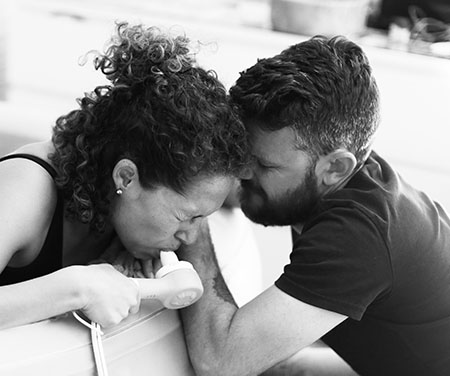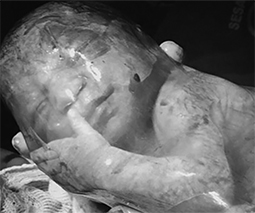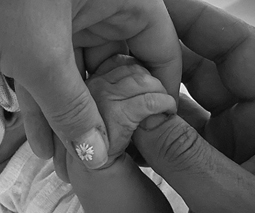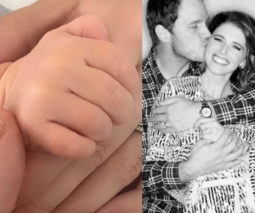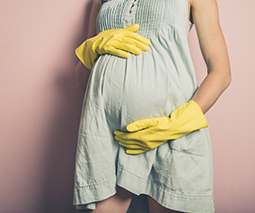10 ways to manage pain and discomfort during labour
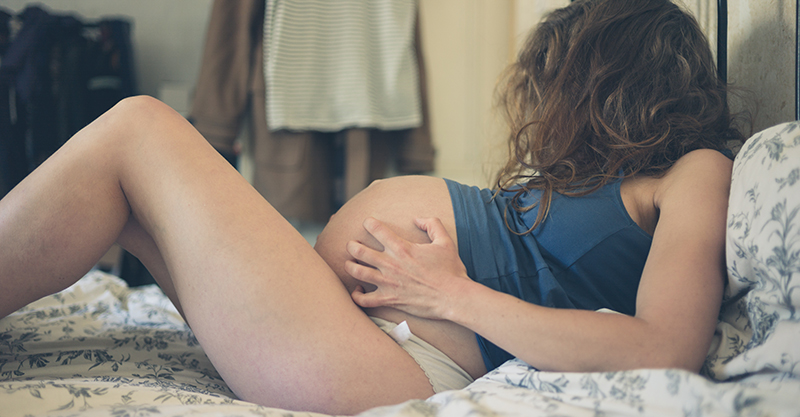
Although every woman is different, most will experience some degree of discomfort or pain during the labour and birthing process. The pain or discomfort felt is usually a complex combination of physical (pressure and stretching of the uterus, cervix, joints, ligament, vagina and perineum) and psychological aspects (fear and tension). In 2014, 77% of women used some sort of pharmacological pain relief option during labour, nitrous oxide gas (54%) and epidurals (34%) being the most popular pharmacological choices. Below is an explanation of some natural and pharmacological pain relief options that are available in most Australian hospitals.
Natural techniques
1. Breathing and Relaxation
Breathing and relaxation can help you drift into a calm state, which will assist in reducing feelings of anxiety/panic and allows the body’s natural pain relieving endorphins to be released. Being in a relaxed state helps your uterus contract efficiently, allows oxytocin (a hormone needed for contractions) to do its job, saves precious energy and can increase the oxygen getting to the baby. Focusing inwardly whilst taking deep long breathes in and out through your nose (to keep your mouth and jaw loose) will help you achieve the relaxed state. Breathing and relaxation is the basis of programs such as CalmBirth and Hypnobirthing and practice is required throughout the pregnancy for best results.
2. Aromatherapy
Oils can be massaged into the skin (with a carrier oil), used in a bath or inhaled using a diffuser or burner to help reduce anxiety, fear, pain and nausea. Common essential oils used in labour are lavender, chamomile, peppermint, jasmine and clary sage but consultation with an experienced aromatherapist is always recommended prior to using any essential oils, especially during pregnancy.
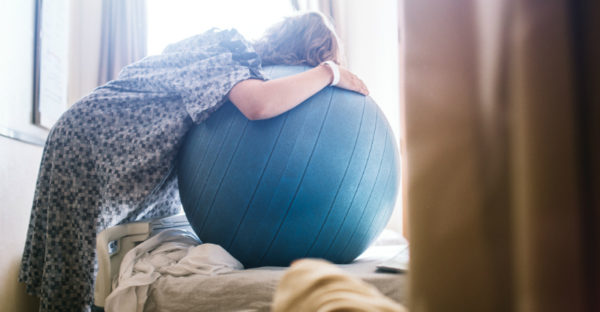
3. Position changes
Pelvic dimensions change with different maternal positions and can make a huge difference in pain perception and the length of the labour. Squatting and kneeling while learning forward have both shown (via MRI) to increase the pelvic diameters substantially, allowing baby to engage and pass through more easily. Different positions can work best at different times so changing positions as you please throughout labour works best. Walking, rocking, lunging and pelvic tilts also assist in changing the dimensions and help the baby get into the most optimal position for a speedy labour. Ask your midwife or support person to suggest other positions if you begin to look uncomfortable.
4. Massage
Massage provides physical and mental calming and comfort, relief of muscle tension and can communicate support and commitment from your support person. Popular massage techniques include:
- Using the heel of the hand to massage the lower back, coccyx and sacrum in slow firm circular movements pressure as it counters the pressure felt as baby moves down through the pelvis.
- Roll the shoulder and neck muscles between thumb and fingers.
Using massage oil infused with an essential oil such as lavender can aid in the calming and pain relieving process. It is not uncommon for labouring women to not want to be touched at certain stages in the labour, let your support person know if this is the case.
5. Transcutaneous Electrical Nerve Stimulation (TENS)
A TENS machine is a small, portable, battery operated device that sends a pulsed electrical stimulus (feels like a tingling sensation) to nerves via electrode pads placed on the skin. They assist with reducing back pain associated with labour by causing the body to release natural endorphins and by blocking the pain messages being sent to the brain from the area of concern. They are safe for both mother and baby, highly effective, non-invasive and you can stay active throughout your labour with the bonus of being able to use it in conjunction with other pain relief techniques. The pads and machine need to be removed for the shower or bath and should not be used prior to labour unless advised by your doctor. It’s a good idea to have read the manual (or even just the quick guide) prior to using it in labour so you are confident in the placement of the pads and utilising all the functions. Some health funds will cover the cost of purchase (usually under medical appliances in policy) so check with yours.

6. Warm water immersion (bath or shower)
Water is a simple, effective and readily available pain relief option. Warm water immersion can provide comfort and pain relief during labour as the buoyancy enables relaxation and weightlessness. Heat also relaxes the muscles and blocks the pain pathways to the pain. You can use the bath and/shower at home when pre-labouring to help with pain and discomfort. Safety is the most important consideration when the midwife/doctor/hospital considers whether you are a good candidate for using warm water immersion/ having a water birth. Many women chose to birth their babies in the water due to the relaxing effect the warm water brings. Some women fear that their baby may drown in a water birth but the baby actually has several protective mechanisms to stop them from breathing under water. If both you and your baby are healthy with no complications, don’t need to be monitored, you can easily get yourself in and out of the bath with minimal assistance and have no epidural then talk to the midwifery or medical staff about using warm water immersion to reduce your pain.
7. Sterile water injections
Sterile water injections (SWI) are a fairly new, but effective method used to relieve back pain in labour. The procedure involves injecting a small amount of sterile water (0.01 ml – 0.02 ml) under the skin at four locations on the lower back (sacrum) simultaneously by two midwives. The injections cause a brief but intense stinging sensation (like a wasp sting) that lasts for about 30 seconds and then wears off completely. As the stinging sensation eases, you will gain relief from your back pain for up to two hours. SWI’s have no effect on the baby or the mother’s mobility or state of consciousness. The SWI will not provide pain relief from contraction pain but once the back pain is alleviated, women are usually able to cope better with the contraction pain. Not all midwives are trained in giving SWI’s so ask at your antenatal appointments if they are used at your hospital.

Pharmacological
8. Gas/Nitrous Oxide
Nitrous Oxide is a mixture of nitrous oxide and oxygen which when inhaled via a mouthpiece acts as a relaxant to take the edge off contractions. It is quick acting and is also dispelled by the body in about 15 seconds once you’ve stopped breathing in the mixture. There are no known side effects to the baby but can cause nausea, a dry mouth and a feeling of being ‘high’ in mothers. The mixture of nitrous oxide and oxygen can be titrated to your needs, giving you some control over the relief needed. Throughout a contraction, you take long, deep breaths from the mouthpiece, breathing normally once the contraction is over. It can be used in conjunction with other pain relief methods such as with sterile water injections, TENS and in the bath/shower.
9. Morphine Injection
Morphine is an opioid that alters the perception of pain and the emotional response to pain by binding to many opioid-receptor sites in the central nervous system. Morphine is given via an Intramuscular injection (IMI) into the leg or bottom and the full effect is usually felt about 30 to 60 minutes post administration. It can cause drowsiness, mental clouding and vomiting in labouring women and crosses to the baby via the placenta. Due to it being excreted slower by neonates, it can cause respiratory depression and they may require some resuscitation at or after the birth. It can also cause issues with the commencement of breastfeeding due them being sleepy in the hours after birth.
10. Epidural
An epidural is the insertion of a needle (replaced by fine plastic tubing) into the epidural space in your lower spine by an anaesthetist. An initial anaesthetic is injected and works on the nerves that carry pain messages from the uterus and birth canal to the brain. Hospitals have different ways to administer the drugs throughout the rest of the labour due to hospital policies and preferences but usually there will be a background infusion of the anaesthetic that can be ‘topped up’ by you by pressing a button when extra pain relief is needed. When the epidural is working well, the pain of labour or procedures associated with birthing may be completely or partially relieved. You can request an epidural at anytime during active labour, but as they can take some time to organise and insert, it is usually too late once you are fully dilated or pushing. After the insertion, inform your midwife if your epidural is not working adequately and they can contact the anaesthetist to see what can be done.
Most women will be bed bound (due to numb legs) once the epidural is inserted, will need an IV cannula inserted, a catheter to drain the bladder and the baby will be continuously monitored via a CTG. Epidurals are considered ‘safe’ and are the most effective way of relieving all pain felt from labour but it does come with side effects. Due to the medications used it can cause your blood pressure to drop, make you feel itchy or have uncontrolled shivers, it may slow down the progress of the labour, increase pushing time and also increase the risk of needing an instrumental delivery or emergency c-section. More serious complications of an epidural include a post dural puncture headache (sometimes requiring a blood patch to fix), infection at the insertion site and serious and permanent nerve damage/paralysis.
Bel Moore is a Lactation Consultant (IBCLC), Midwife, Child and Family Health Nurse, Nurse Immuniser, Babywearing Consultant and mum of two beautiful boys.
